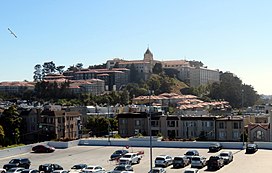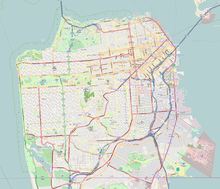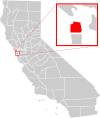| Lone Mountain | |
|---|---|
 Lone Mountain from the northeast in 2020 | |
| Highest point | |
| Elevation | 421 ft (128 m) NAVD 88 [1] |
| Coordinates | 37°46′45″N 122°27′07″W / 37.7790963°N 122.4519159°W [2] |
| Geography | |
| Location | San Francisco, California |
| Topo map | USGS San Francisco North |
Lone Mountain is a neighborhood and a historic hill in west-central San Francisco, California. It is the present site of the northern half of the University of San Francisco's main campus. It was once the location of the Lone Mountain Cemetery, a complex encompassing the Laurel Hill, Calvary, Masonic and Odd Fellows Cemeteries. [3]
History
Lone Mountain is one of San Francisco's historic hills. The Spanish name for Lone Mountain was El Divisadero, from the Spanish divisadero, which means a point from which one can look far. [4]
The Lone Mountain Cemetery was opened on May 30, 1854. [5] [6] In 1867, the cemetery was renamed Laurel Hill Cemetery. [5] After decades of litigation and public debate, the gravesite remains were all moved, primarily to Cypress Lawn Memorial Park in the city of Colma, immediately south of San Francisco. In what writer Harold Gilliam described as "an act of civic vandalism", thousands of crypts and mausoleums were unearthed, the granite and marble dumped along the Pacific shoreline to reinforce seawalls. [7]
The Lone Mountain College (formerly Sacred Heart Academy and San Francisco College for Women) was founded in 1898; and changed leadership and ownership many times, before becoming part of USF. The Lone Mountain area is also known as "University Terrace" because of the terraces that connect the two USF campuses.
- Lone Mountain history
-
Lone Mountain
-
Watercolor (1910) by Alice Brown Chittenden. Tents are remnants of camps after the 1906 earthquake.
-
Odd Fellows Cemetery, 1899
Neighborhood
The Lone Mountain neighborhood of San Francisco is a vibrant community which includes residential and commercial areas, and is a university community. [8] It is also the site of the Angelo J. Rossi Playground and Rossi Pool located at Arguello Boulevard and Anza Street. [9]
See also
References
- ^ "Lone Mountain, California". Peakbagger.com. Retrieved March 4, 2014.
- ^ "Lone Mountain". Geographic Names Information System. United States Geological Survey, United States Department of the Interior. Retrieved May 17, 2010.
- ^ Kastler, Deanna L. "Cemeteries". Encyclopedia of San Francisco. San Francisco Museum & Historical Society. Archived from the original on July 22, 2010. Retrieved May 22, 2010.
- ^ "Appendix B: Streets of San Francisco". San Francisco History. San Francisco Genealogy. Retrieved March 4, 2014.
- ^ a b Tamara Venit Shelton (2008). "Unmaking Historic Spaces: Urban Progress and the San Francisco Cemetery Debate, 1895-1937" (PDF). California History. 85 (3): 26-47. Archived from the original (PDF) on April 16, 2016.
- ^ "Laurel Hill Cemetery". Daily Alta California. April 12, 1867.
- ^ Thompson, Walter J. "In The Shadow of Lone Mountain". San Francisco History. SFgenealogy. Retrieved April 20, 2022.
- ^ Kastler, Deanna L. (Winter 1992). "Lone Mountain, Lone Mountain & Laurel Hill: From Necropolis to Residential, Commercial, & University Neighborhoods". The Argonaut. 3 (1). Exceprts online at Kastler, Deanna L. "Lone Mountain". FoundSF. Retrieved October 15, 2022.
-
^ Whiting, Sam (November 26, 2021).
"Francisco Reservoir on Russian Hill set to reopen as public park in early 2022". San Francisco Chronicle. Retrieved October 15, 2022.
- Keraghosian, Greg (October 30, 2016). "Places in San Francisco you had no idea used to be cemeteries". SFGATE. Retrieved October 15, 2022.
External links
- Proctor, William A. (1950).
"Location, regulation, and removal of cemeteries in the City and County of San Francisco". Department of City Planning, City and County of San Francisco.

- Encyclopedia of San Francisco Article on cemeteries




